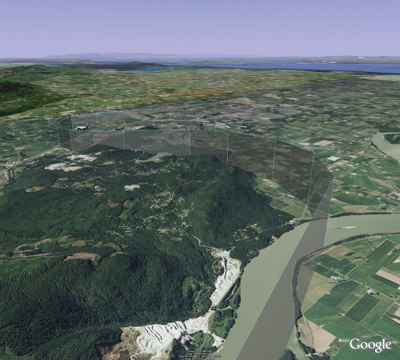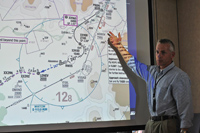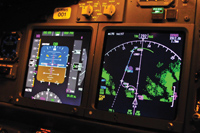
Features
Air Traffic
Rounding The Corners
Those involved in aviation tend to get excited about most new technological advances.
July 14, 2010 By James Marasa
Those involved in aviation tend to get excited about most new technological advances. Yet now and then, certain enhancements present themselves in such a remarkable way, that it’s as though we’re glimpsing into the future. New technologies in aviation are often looked at in terms of potential lives saved. Yet with the ever-growing burden of man’s impact on the world’s climate, a corresponding benefit to our environment, such as an increase in fuel efficiency, could not be more timely.
 |
|
| A 3-D image of WestJet’s RNP approach to runway 25 at Abbotsford highlights how PBN is opening up new routes in obstacle-rich environments. ILLUSTRATION: nav canada |
No type of incident has proven more ominous and far-reaching than controlled flight into terrain (CFIT). During an instrument approach, an aircraft lacking a method of vertical guidance to a decision height is five times more likely to collide with the Earth than if it were following a precision approach such as an ILS. Such impactful evidence has led ICAO to request that states establish approach procedures with vertical guidance to all instrument runway ends by 2016.
The fact that ILS equipment is costly is no secret; therefore, in lieu of relying on ground-based equipment, certain operators have found unique application for an advanced form of GPS navigation known as Required Navigation Performance (RNP). This is revolutionizing the way instrument approaches are designed and carried out, most notably in areas of hazardous terrain.
For Calgary-based WestJet, a comprehensive utilization of RNP became a realistic possibility at the roll-out of its first next-generation Boeing 737 in 2001. “The impetus for implementing RNP was safety,” says Capt. David Deere from WestJet’s home office. After serving on CF-18s in the first Gulf War and flying with the Snowbirds from 1994 through 1995, Deere’s latest challenge is shepherding RNP into flight operations as project manager for WestJet’s RNP program.
“RNP was brand new in 2001 . . . . No one knew anything about it,” says Deere. “We knew about the capability for RNP in the 737NG but didn’t realize its full implications.”
 |
|
| Capt. David Deere, RNP project manager at WestJet, introduces the new company RNP approach to runway 25 at Abbotsford. PHOTOs: Edward Lee |
According to Deere, WestJet approached RNP with the initial goal of eliminating multiple step-down “dive and drive” non-precision and circling approaches as well as reducing costly diversions. Yet after delving into the unique capabilities RNP had to offer, Deere confesses that the end result was “beyond expectations.”
Though both Area Navigation (RNAV) and GPS are modern staples in the everyday operations of commercial air carriers, their application has generally been limited to straight-line tracks between waypoints – perfectly suitable in the realm of en-route navigation, but limited in terms of flexibility. This has led to rigid instrument approach procedures with squared-off turns from base leg to final. As no airplane can actually perform a 90-degree course change over the ground, these “fly-by waypoints” serve as a guide while the actual track of the aircraft is markedly different from the perpendicular angles of the tracks depicted on the approach plate.
Required Navigation Performance offered the opportunity to change all that. Four years ago, when Deere took the reins of WestJet’s RNP program, he began to look at how the Performance-Based Navigation (PBN) capacity of the new 737 could help WestJet shave time and distance off existing procedures.
Performance-Based Navigation allows aircraft to accurately navigate along flexible, linear surfaces rather than point-to-point as does a standard GPS. Departure and instrument approach procedures can therefore be designed to quite literally “curve” around terrain and obstacles. With lateral position tolerance as low as 0.1 of a nautical mile, this capability has opened up new routes and improved WestJet’s service at airports surrounded by mountainous terrain such as Kelowna and Abbotsford.
 |
|
| A series of fixed-radius turns to final depicted in the cockpit of a WestJet Boeing 737NG simulator. PHOTOs: Edward Lee
|
Expansion of the PBN concept has led approach designers such as GE Naverus – a Seattle-based company who has worked closely with WestJet on the RNP program – to venture beyond the safety benefits of PBN and examine ways to save fuel and reduce greenhouse gas (GHG) emissions through improved aircraft efficiency. Such innovation has given rise to the short transition – a procedure built into the RNP/RNAV approach whereby the aircraft may navigate to the final approach course by means of a fixed-radius turn as it approaches the airport from a downwind or base leg. Colloquially referred to by pilots and controllers as the “Short Gate,” these arced transitions to final comprise 50 out of WestJet’s 80 RNP approaches. WestJet Flight Operations estimates the RNP approaches at Kelowna and Abbotsford have saved 265,000 and 285,000 litres of fuel annually at these airports. This translates to a reduction of 677 and 728 metric tons of GHG emissions.
During IFR weather when a precision approach is not available, the benefits of an RNP approach are immediately apparent. Yet through collaboration with NAV CANADA and GE Naverus, WestJet has opted to implement RNP approaches at airports already served by an ILS. Deere cites several reasons for the apparent redundancy, most notably the fact that an ILS often experiences signal interference and is not always operational due to scheduled maintenance or failure. Required Navigation Performance provides a superb backup in such cases, allowing the aircraft to be self-sufficient in terms of its navigational capacity.
As RNP does not rely on signal reception or the serviceability of ground-based navaids, it benefits smaller airport operators in WestJet’s route network by alleviating them of the need to invest in costly navigational infrastructure, such as ILS equipment. “We bring the technology with us,” says Deere.
In VFR weather, many pilots voluntarily abandon the confines of the instrument procedure for a less restrictive visual approach once the runway is in sight. But pilots at WestJet are beginning to appreciate the efficiency advantages of the Short Gate even over the stalwart visual.
After tracking descent profiles of WestJet’s visual approaches into Prince George, Deere presented a slide showing the graphical representation of each flight path. The enemies in terms of fuel efficiency are the segments of level flight. A 737NG, with gear down and flaps up, will burn fuel at a rate 3.5 times higher in level flight than during a continuous descent profile such as that on an RNP approach.
“A lot of pilots think they can fly more efficient visual profiles than the machine,” says Deere, “but after a close analysis of FDM data, numerous level flight segments really do add up in terms of fuel consumption.”
By taking the lead in the RNP game, one might presume that WestJet would be inclined to keep the technology to itself to preserve a margin of competitive advantage. Some might find it surprising then, that last February, WestJet gave a full briefing to Air Canada on its RNP program.
“The entire Canadian domestic industry is interested in the expansion of PBN,” says Deere. “We get a bigger bang for our buck by getting everyone on board.”
From an air traffic management perspective, integrating RNP procedures with conventional approaches can pose a challenge. WestJet’s utilization of Short Gate approaches at its hub in Calgary is currently only 30 per cent – a figure Deere would like to see rise considerably. WestJet has yet to introduce Short Gate approaches at Montreal, Toronto or Vancouver, as integrating customized company routes into what is already complex and congested airspace is expected to be problematic.
However, Deere believes that if more operators were equipped for RNP, more resources would be allocated to RNP development, thereby increasing WestJet’s utilization of the cost-saving procedures.
Indeed, in the PBN Concept of Operations document released last November, NAV CANADA has indicated that the transition to RNP will occur on a schedule primarily dictated by customer needs and level of equipage. Interestingly, NAV CANADA states that the air traffic control mandate of “first come, first served” will be modified to allow an early return on investment in RNP technology by users.
NAV CANADA is supporting the implementation of RNP/RNAV procedures in Canada through an Air Transport Operations Consultative Committee (ATOCC) working group composed of operators and NAV CANADA personnel. In the meantime, WestJet is paving the way for RNP through innovative approach designs such as the recently published procedure for runway 25 at Abbotsford.
Prior to WestJet’s exemption from CARs approach design criteria, designing an instrument approach to runway 25 was impossible due to terrain and the surrounding Class F airspace. As WestJet almost always approaches Abbotsford from the East, a prevailing westerly wind meant the aircraft would normally have to extend downwind to shoot the ILS for runway 07, only to circle back for 25. With RNP, an innovative procedure was designed for runway 25 which clears all terrain as well as surrounding Class F airspace, leading to a straight-in approach. The result: a saving of 48 track miles, 560 litres of fuel and nearly 1.5 metric tons of GHG emissions.
Collectively, track miles flown have been reduced by well over 100,000 miles per year due to RNP operations. Overall, WestJet estimates that the efficiencies attributable directly to the RNP program will result in a reduction of GHG emissions by 4,930 tonnes of CO2 in 2010.
“Give us a reason not to do it,” says Deere.
While it remains to be seen exactly what public RNP approaches will look like, there can be no doubt that, as operators continue to modernize their avionics, we will be seeing more fixed-radius turns to final. At any rate, sometimes the shortest distance to the runway is not a series of straight lines.
| Increasing efficiency WINGLETS TAKE FUEL CONSERVATION TO NEW HEIGHTS
Winglet Technology BLR Winglet System Aviation Partners Blended Winglets Penta Aviation Services in Richmond, B.C., is the exclusive Canadian dealer for Hawker Beechcraft Winglets from BLR. It is also the only Canadian installation centre for Blended Winglets from Aviation Partners. www.penta-aviation.com |
In a resounding vote of confidence, NAV CANADA was the recipient of this year’s Eagle Award for best air navigation service provider from the International Air Transport Association (IATA). President and CEO John Crichton accepted the award on behalf of all NAV CANADA employees at the IATA Annual General meeting in Berlin on June 7.
Please visit www.wingsmagazine.com and click on web exclusives to read an aritcle by NAV CANADA called A Safer Approach: Pursuit of flight efficiency pays green dividend for air navigation system customers. The article discusses innovative approaches that NAV CANADA has been using to help its airline customers reduce fuel consumption.
 In keeping with the goal of decreasing fuel consumption, many companies are improving the efficiency of their aircraft by incorporating wingtip devices such as winglets. Here’s a look at how a few companies are taking fuel consumption reduction strategies to new heights with winglets.
In keeping with the goal of decreasing fuel consumption, many companies are improving the efficiency of their aircraft by incorporating wingtip devices such as winglets. Here’s a look at how a few companies are taking fuel consumption reduction strategies to new heights with winglets.